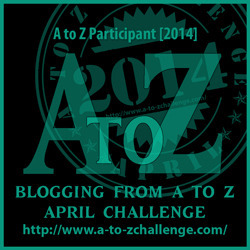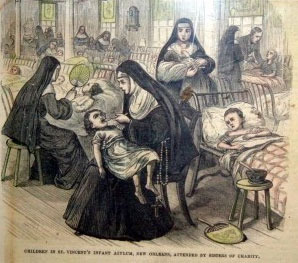The A to Z Challenge – Y for Yellow Fever in New Orleans 1853
 The LAST WEEK in the A to Z Challenge ! Hello and welcome to my Main blog. My name is Rose Anderson and I’m a romance novelist. Join me and more than 2279 bloggers and authors as we blog the alphabet throughout the month of April. My daily posts will be mostly history with some science topics here and there. I’ve chosen subjects that tickle my fancy, I hope you will find them interesting too.
The LAST WEEK in the A to Z Challenge ! Hello and welcome to my Main blog. My name is Rose Anderson and I’m a romance novelist. Join me and more than 2279 bloggers and authors as we blog the alphabet throughout the month of April. My daily posts will be mostly history with some science topics here and there. I’ve chosen subjects that tickle my fancy, I hope you will find them interesting too.
Keep the topic rolling! If you have comments or questions, add them at the end of the post. I may not know the answer off the top of my head but I love research and would enjoy discussing my topics further. Comments can be made in the tag section at the bottom of the post.
*FREE* If you enjoy reading scorching romances with unique twists and characters full of personality and depth, scroll down for a free chapter sampler. Find my book trailers in the tabs above.
۞>>>>۞<<<<۞>>>>۞<<<<۞>>>>۞
 Today’s Calliope’s Writing Tablet post is brought to you by the letter Y ~
Today’s Calliope’s Writing Tablet post is brought to you by the letter Y ~
Y for Yellow Fever in New Orleans 1853
As mentioned in my V for Vaccination post, microbes are fairly amazing for their ability to adapt. Insects are also remarkable for their adaptability, even managing to live through high-level exposure to radiation. Now put the two together. Yikes. Sure, the flea killed more than half of the population of old Europe, and the tick brings its own share of misery with Lyme Disease et al, but the mosquito epitomizes vector like no other. These are some of the known diseases the mosquito spreads:
Encephalitis:
Eastern equine encephalitis
Japanese encephalitis
La Crosse encephalitis
St. Louis encephalitis
West Nile virus
Western equine encephalitis
Dengue Fever
Chikungunya
Malaria
Rift Valley Fever
Yellow Fever
Today I’m talking about the Yellow Fever outbreak in [image error]New Orleans. But first a little background…
Transmitted by the bite of a female Aedes aegypti mosquito, Yellow Fever is an acute infectious viral disease seen in tropical and subtropical regions of South America and Africa. Like the deadly Lassa Fever, Dengue Fever, and Ebola, Yellow Fever is also a hemorrhagic (bleeding) disease. It begins with aches and pains, and fever follows along with nausea and dizziness. Symptoms initially last several days before tapering off.
You’d think at this point the worst is over. Far from it. From here it does something unusual. The symptoms return with a vengeance. As the disease spreads to the liver, this phase brings the name-inspiring jaundice that yellows the eyes and skin. Delirium follows as does internal hemorrhaging (bleeding from the ears and nose, and black vomit). In the terminal phase, the organs and circulatory system fail and death generally follows 7-10 days after the relapse. But, if by some miracle you manage to live through all that, you’ll have a life-long immunity. There is no treatment other than vaccination.
Hit hard in the Big Easy.
The country was well-acquainted with Yellow fever having already had it’s outbreak during the French Revolution. At that time, Philadelphia was the largest city in the United States with more than 50,000 residents. Those fleeing the French Caribbean colony of Saint Domingue (Haiti today) landed on the Philadelphia docks. These French expatriates brought a plague of Yellow Fever with them. Of the 50,000 people living in Philadelphia in 1793, less than 8000 people survived. By the 1800′s people still had no idea that mosquitoes were to blame for Yellow Fever. They still operated under the assumption bad smells were to blame. A common and useless practice was to purify the air of the miasma by burning tar or feathers.
From here I’ll paint you a picture…
That May in 1854, New [image error]Orleans Louisiana had a population of 154,000 people. Steeped in French Influence, New Orleans with its old world ways was considered the Paris of the New World. As cosmopolitan as any port city, it was populated with boatloads of fresh immigrants who mixed and mingled with the French, Spanish, Native Americans, and African American’s there. And for all these people, sanitation was less than desirable. I discovered this tidbit on the lack of sanitation from a doctor living there in 1853:
“Worse and worse. The late rain has only stirred up the sinks.
Tilth, dirt, decayed cabbage-stalks, dead dogs, and worse, are the
fascinating ornaments of our thoroughfares, at the very time when
the energies of our authorities should be devoted to the preser
vation
of the health of our citizens, which can be secured only by
sanitary improvements. The nuisance is becoming altogether
in
supportable, and everybody suggests that something must be done,
and, day after day, that important ‘something’ ends in nothing.”
Small wonder they blamed bad smells on illness.
Trade on the Mississippi was bustling and this influx of ships brought the disaster to come, for ships bring water barrels and illnesses from other places. The first victims that May were sailors from the ship Augusta who turned up at the charity hospital with a host of symptoms that included “hot and dry skin, pulse of 100, violent headaches, pains in the back and limbs, tongue coated, foetid breath, nausea and vomiting of black bilious matters”. Their skin and eyes soon took on that tell-tale yellowish cast. It turned out they’d just come to the busy American port from Kingston Jamaica. Though they were exposed to the Yellow Fever there, their ship had been cleansed with a “good sprinkling of lime”.
 Late spring weather was warm as it always was on the bayou. But that May saw more than 5 inches of rainfall and temperatures hovering at a steamy 88°, weather more suited to July. To the people living there, the mosquitoes were the usual nuisance that came on heavy in June and lasted until the cooler November weather brought relief. That May, the pests bred in the fetid filth and the still backwaters. They went from person to person in search of a blood meal and spread disease from those already infected. The fuse of an epidemic was lit.
Late spring weather was warm as it always was on the bayou. But that May saw more than 5 inches of rainfall and temperatures hovering at a steamy 88°, weather more suited to July. To the people living there, the mosquitoes were the usual nuisance that came on heavy in June and lasted until the cooler November weather brought relief. That May, the pests bred in the fetid filth and the still backwaters. They went from person to person in search of a blood meal and spread disease from those already infected. The fuse of an epidemic was lit.
An average of 1,300 people died each week in August. On one August day alone, 230 deaths were reported, spurring newspapers to refer to it as the Black Day. Mortality was higher among Irish immigrants– one out of every five people infected died. By the time the disease had run its course in November, one out of every twelve people, a full 5% of the population, had perished. Curious at the time, this outbreak illustrated a racial disparity in Yellow Fever mortality. It’s estimated that while 7.4% of the white residents of New Orleans died, only 0.2% of African Americans did — the result of millennia of acquired immunity. The Aedes aegypti mosquito originated in Africa.
Footnote: Between 1817 and 1905 in excess of 41,000 people died from this vector borne disease. In 1900, Dr. Walter Reed and his colleagues proved Yellow Fever was spread by mosquitoes. Eradication followed.
The spread of the disease month by month
More~
The anniversary issue of the Daily Picayune newspaper
http://media.nola.com/175years/other/175.yellowfever.pdf
An interesting overview of New Orleans
Tomorrow ~ letter Z!!
۞>>>>۞<<<<۞>>>>۞<<<<۞
 See what’s happening on the RB4U blog today
See what’s happening on the RB4U blog today
http://romancebooks4us.blogspot.com/
Our new May contest is on. We’ll have 1 winner for all prizes. http://www.romancebooks4us.com/
۞>>>>۞<<<<۞>>>>۞<<<<۞
Love Waits in Unexpected Places -
Scorching Samplings of Unusual Love Stories
https://www.smashwords.com/books/view/333971
Download your copy of my free chapter sampler!

۞>>>>۞<<<<۞>>>>۞<<<<۞>>>>۞<<<< ۞>>>>۞<<<<۞>>>>۞<<<<۞






